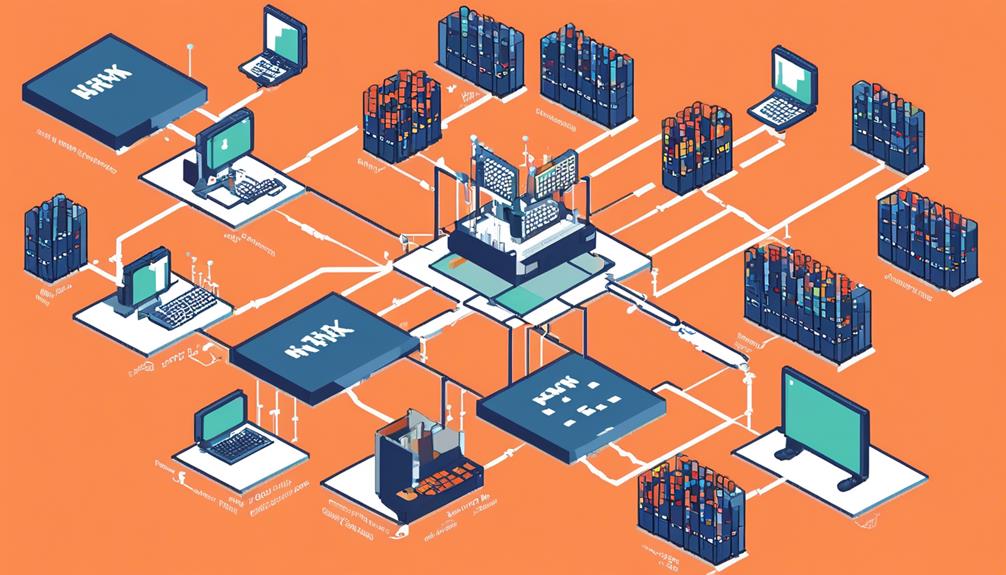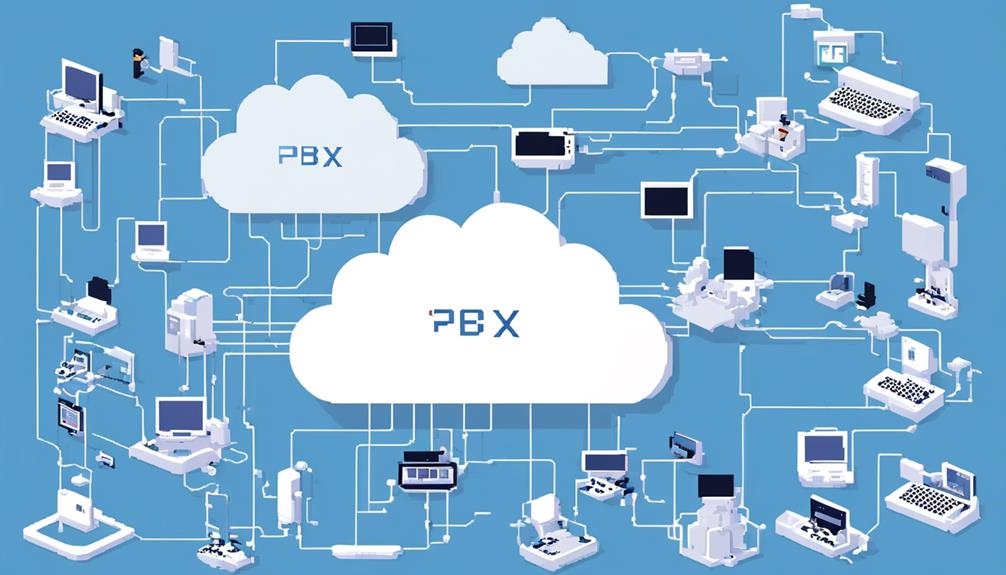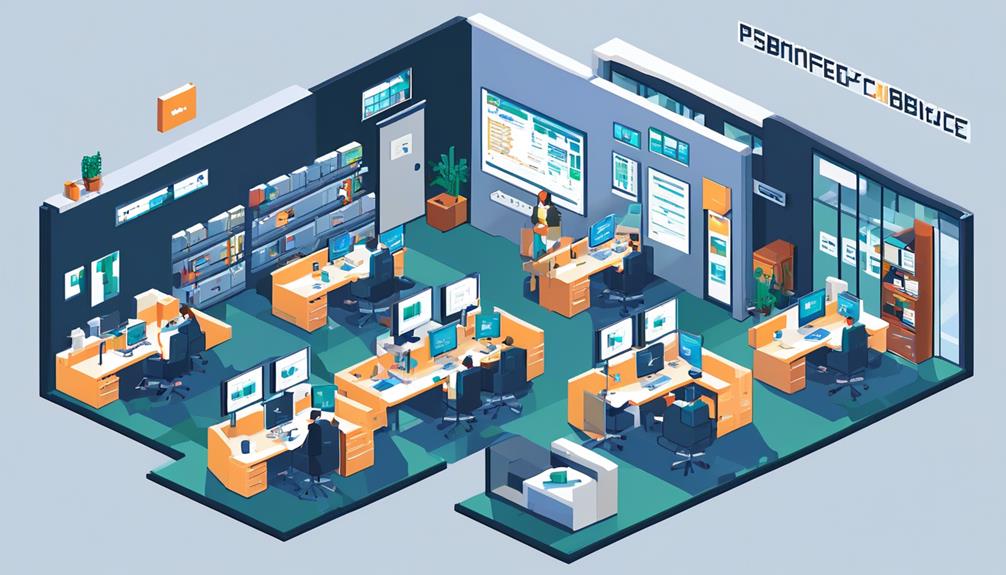The scalability of PBX systems is a critical factor to consider in today's ever-evolving business landscape. As organizations grow and their communication needs expand, it becomes essential to have a PBX system that can effortlessly adapt to increasing demands. Scalability ensures that the system can handle a larger number of users, higher call volumes, and the integration of advanced features without compromising performance.
In this discussion, we will explore various aspects of scalability in PBX systems. This includes cloud-based solutions, hybrid approaches, modular architecture, SIP trunking, and VoIP integration. These different approaches offer flexibility and scalability options for businesses.
Additionally, we will delve into the benefits of PBX systems for business growth. This includes customization options, geographic expansion, and accommodating remote workers. PBX systems can be tailored to meet the specific needs of a growing business, whether it's adding new locations, integrating with other systems, or supporting a remote workforce.
By understanding the scalability options available, businesses can make informed decisions to future-proof their communication infrastructure and support their growth objectives. A scalable PBX system can adapt to changing requirements and ensure that communication remains efficient and effective as the organization expands.
Key Takeaways
- Modular architecture allows for easy scalability of PBX systems.
- SIP Trunking and VoIP integration enable seamless scalability.
- Network monitoring is crucial for monitoring and maintaining the scalability of PBX systems.
- PBX systems offer scalable business solutions to meet the growing needs of organizations.
Cloud-Based PBX Systems

Cloud-based PBX systems utilize off-site servers accessible via the internet to store and transfer voice and data, providing businesses with scalable solutions for managing call volume, user growth, advanced features, geographical expansion, and cost optimization. These cloud PBX systems offer businesses the flexibility to easily scale their communication infrastructure based on their evolving needs.
Scalability is a critical aspect of cloud PBX systems, allowing businesses to accommodate user growth without the need for significant hardware investments. With cloud-based deployment, businesses can leverage the resources of the cloud infrastructure to adapt to changing requirements. The virtualization within cloud-based PBX systems further facilitates scalable deployment, management, and expansion of the communication infrastructure, reducing the IT workload.
Additionally, cloud-based PBX systems offer multi-tenant IP PBX solutions, enabling businesses to have a single communication infrastructure that serves multiple tenants. This multi-tenant architecture provides scalability by efficiently utilizing the shared resources of the cloud infrastructure, resulting in cost optimization and improved efficiency.
The scalability of cloud PBX systems also enables businesses to manage call volume effectively. As call volumes fluctuate, businesses can easily scale up or down their communication resources to ensure smooth call handling and optimal performance.
Moreover, cloud-based PBX systems support advanced features that enhance communication capabilities. These features can be easily added or removed as per the business needs, providing businesses with the flexibility to leverage the latest communication technologies and stay competitive in the market.
Hybrid PBX Solutions
To further enhance communication infrastructure and cater to diverse needs, businesses can adopt hybrid PBX solutions, which combine the benefits of on-premises and cloud-based systems. These solutions offer the best of both worlds by integrating traditional phone lines with Voice over Internet Protocol (VoIP) technology, providing flexibility and scalability.
Hybrid PBX solutions allow businesses to gradually transition to cloud-based services while maintaining their existing on-premises infrastructure. This enables organizations to leverage the cost-effectiveness of on-premises infrastructure and the scalability of cloud-based technology. By combining the two, businesses can achieve a balance between control and scalability, ensuring their communication system can meet their evolving needs.
To provide a visual representation of the benefits of hybrid PBX solutions, consider the following table:
| Benefits of Hybrid PBX Solutions | ||
|---|---|---|
| Flexibility | Scalability | Cost-effectiveness |
| Ability to integrate traditional phone lines with VoIP technology | Incremental scalability to accommodate growth | Utilization of existing on-premises infrastructure |
| Gradual transition to cloud-based services | Support for diverse communication needs | Reduction in overall operational costs |
As shown in the table, hybrid PBX solutions offer flexibility by allowing businesses to integrate both traditional phone lines and modern VoIP technology. Additionally, these solutions provide incremental scalability, enabling organizations to accommodate growth without the need for significant infrastructure investments. Furthermore, by leveraging existing on-premises infrastructure, businesses can achieve cost-effectiveness while still benefiting from the scalability of cloud-based solutions.
Modular and Open Architecture

Modular and open architecture is a key aspect of PBX systems, offering flexibility and integration capabilities. With modular architecture, businesses can customize their systems to meet specific requirements without sacrificing performance.
Open architecture enables seamless integration with various applications and devices, such as CRM platforms, email, chat, mobile, and video, enhancing communication capabilities and streamlining workflows.
These advantages make modular and open architecture an essential consideration for businesses seeking scalable PBX solutions.
Flexibility in PBX
The flexibility of PBX systems is greatly enhanced through the implementation of a modular and open architecture, allowing for seamless customization and integration with various applications and devices. This modular approach enables businesses to tailor their PBX system according to their specific communication requirements without compromising performance. Moreover, the open architecture of PBX systems facilitates integration with CRM, email, chat, mobile, and video platforms, enabling organizations to streamline workflows and enhance communication capabilities. The table below highlights the benefits of a modular and open architecture in PBX systems:
| Benefits | Explanation |
|---|---|
| Customization | Modular architecture allows businesses to customize their PBX system as needed. |
| Integration with other applications | Open architecture enables seamless integration with various applications and devices. |
| Scalability | The modular and open architecture of PBX systems supports easy scalability. |
| Workflow optimization | Integration with different platforms enhances workflow efficiency and productivity. |
| Enhanced communication capabilities | The flexibility of PBX systems enables businesses to improve their communication needs. |
Integration of Modules
The integration of modules in PBX systems, enabled by their modular and open architecture, enhances customization and the seamless integration with various applications and devices.
This scalability allows businesses to customize their PBX systems according to their specific requirements, ensuring optimal performance without sacrificing flexibility.
The modular architecture enables easy integration with customer relationship management (CRM) systems, email platforms, chat applications, mobile devices, and video platforms.
By integrating these modules, businesses can streamline workflows, enhance communication capabilities, and improve overall efficiency.
With the ability to seamlessly integrate with other applications and devices, PBX systems can adapt to the evolving needs of businesses, making them highly scalable and versatile.
This integration ensures that businesses can efficiently manage their communication infrastructure and stay connected with their customers and stakeholders.
Scalability Advantages
With its modular and open architecture, the scalability of PBX systems can be further leveraged to provide businesses with significant advantages in terms of customization and integration capabilities.
The modular architecture allows for customization without compromising performance, enabling businesses to tailor the system according to their specific requirements. This means that businesses can add or remove modules as needed, ensuring that the system grows with their needs.
Additionally, the open architecture of PBX systems enables seamless integration with other applications and devices such as CRM, email, chat, mobile, and video platforms. This integration enhances communication capabilities and streamlines workflows, resulting in improved productivity and efficiency.
SIP Trunking and Voip Integration

SIP trunking and VoIP integration play a crucial role in enhancing the scalability of PBX systems by enabling seamless communication and efficient management of voice traffic. SIP trunking, which stands for Session Initiation Protocol, is a technology that allows businesses to connect their PBX systems to the internet, enabling the transmission of voice and multimedia sessions over IP networks. VoIP integration, on the other hand, refers to the integration of Voice over Internet Protocol technology into PBX systems, allowing for the transmission of voice calls over the internet.
By implementing SIP trunking and VoIP integration, businesses can experience a range of benefits that contribute to the scalability of their PBX systems. Firstly, these technologies allow for the consolidation of voice traffic, eliminating the need for multiple physical phone lines and reducing costs. This scalability advantage is especially significant for businesses with a growing number of employees or multiple office locations.
Additionally, SIP trunking and VoIP integration enable businesses to easily scale their phone system up or down based on their needs. With traditional phone systems, adding or removing phone lines can be a time-consuming and costly process. However, with SIP trunking and VoIP integration, businesses can easily add or remove extensions as needed, providing flexibility and scalability to meet changing business requirements.
To further illustrate the benefits of SIP trunking and VoIP integration, the following table highlights some key features and advantages of these technologies:
| Feature | Advantage |
|---|---|
| Consolidation | Reduction of physical phone lines and associated costs |
| Scalability | Easily add or remove extensions as needed |
| Flexibility | Ability to integrate with other communication systems |
Network Monitoring for Scalability
Effective network monitoring is a critical component in ensuring the scalability of PBX systems by proactively addressing potential limitations and optimizing resource allocation. Network monitoring for scalability involves tracking and analyzing network performance to ensure it can handle increasing demands. By monitoring the network, organizations can identify potential bottlenecks or issues that may hinder the system's ability to scale effectively.
Network monitoring tools play a crucial role in providing real-time visibility into network traffic, resource utilization, and performance metrics. These tools enable administrators to monitor the network's health, identify any anomalies or performance degradation, and take proactive measures to ensure smooth scalability. Monitoring helps in proactively addressing capacity limitations, optimizing resource allocation, and ensuring the overall performance and reliability of a scalable multi-tenant IP PBX system.
To achieve scalability, organizations need to be able to monitor network traffic and performance metrics in real-time. This enables them to identify any potential issues or bottlenecks that may arise due to increased traffic or resource demands. By monitoring the network continuously, administrators can gain valuable insights into the network's capacity and performance, allowing them to make informed decisions regarding resource allocation and infrastructure upgrades.
Staff Training and Updates

To ensure the scalability of PBX systems, it is essential to prioritize staff training and updates, ensuring that employees remain knowledgeable and proficient in utilizing the latest features and functionalities.
Regular training sessions are crucial for keeping employees up-to-date with the evolving nature of PBX systems. By providing training on new features and functionalities, organizations can empower their staff to make the most of the system's capabilities.
Updates to the PBX system should be promptly communicated to staff to ensure efficient adoption and utilization of new features. This ensures that employees are aware of any changes or improvements made to the system and can optimize their usage accordingly.
Furthermore, training sessions should be tailored to different user roles and responsibilities within the organization. This approach maximizes the system's potential by providing targeted training that addresses specific needs and requirements.
Staff training and updates play a vital role in maintaining a high level of system knowledge and proficiency. By investing in ongoing training, organizations can enhance employee productivity and customer satisfaction. Well-trained staff can effectively handle customer calls, resolve issues efficiently, and provide a seamless communication experience.
Additionally, staff training and updates help identify and address any user-related issues that may arise. By actively engaging employees in training sessions, organizations can gather feedback, identify pain points, and address them promptly. This contributes to the smooth operation of the PBX system and ensures that it remains a scalable and reliable solution.
System Review and Adjustments
The evaluation and optimization of the current PBX system's performance are essential steps in ensuring its efficiency and adaptability in a dynamic business environment. Regular system review and adjustments enable organizations to identify areas for improvement and make necessary changes to optimize functionality.
Here are four key considerations for conducting a comprehensive system review and implementing effective adjustments:
- Performance Evaluation: Monitoring system performance is crucial to identify any bottlenecks or inefficiencies. It involves analyzing call quality, response times, and overall system reliability. By identifying performance issues, organizations can take targeted actions to address them and enhance the scalability of the PBX system.
- User Feedback: Gathering feedback from users, such as employees and customers, provides valuable insights into their experiences with the system. This feedback can help identify pain points, user interface issues, or feature requests. Incorporating user feedback into the system review process allows organizations to make adjustments that enhance usability and user satisfaction.
- Evolving Communication Requirements: The communication needs of an organization can change over time due to growth, technological advancements, or evolving business objectives. Regular system review ensures that the PBX system aligns with these changing requirements. Adjustments may involve adding new features, expanding capacity, or integrating with other communication tools to meet evolving needs.
- Scalability Optimization: Scalability is a critical factor in the success of a PBX system. During the system review, organizations should assess the scalability of their current infrastructure and make adjustments to support future growth. This may include optimizing resource allocation, reconfiguring the system architecture, or implementing cloud-based solutions for increased scalability.
Telecommunication System Considerations

Assessing the capacity and functionality of a telecommunication system to handle increasing demands while maintaining performance and quality is a crucial consideration in ensuring its scalability. When it comes to PBX systems, specifically multi-tenant IP PBX solutions, the ability to seamlessly accommodate a larger number of users, handle higher call volumes, and support additional features and functionalities is of utmost importance.
To achieve scalability, it is essential to implement scalable solutions that offer the necessary flexibility and resources to effectively meet growing demands in multi-tenant IP PBX systems. This involves careful system design, architecture, flexible licensing, and cloud-based deployment. By leveraging these elements, organizations can ensure that their telecommunication system can effortlessly scale up to meet the needs of their expanding user base.
Moreover, scalable solutions not only address the current requirements but also help future-proof the communication infrastructure. This means that the system can seamlessly adapt to new capabilities and changes in the business environment. As technology evolves and new features become available, a scalable telecommunication system can easily integrate these advancements without compromising performance or quality.
Scalability of Hosted PBX Systems
When considering the scalability of telecommunication systems, the ability of hosted PBX solutions to seamlessly handle increasing communication demands while maintaining performance and quality becomes a critical factor. Scalability is a key feature of hosted PBX systems, ensuring that businesses can effectively adapt to their evolving communication needs.
Here are some key points to consider regarding the scalability of hosted PBX systems:
- Flexibility: Hosted PBX solutions should have the flexibility to accommodate a growing number of users, higher call volumes, and additional features as businesses evolve. This flexibility ensures that organizations can scale their communication system without limitations.
- Multi-tenant IP PBX: Scalable multi-tenant IP PBX solutions offer the necessary resources and adaptability to effectively meet growing communication demands. These solutions allow multiple organizations to share common hardware and software resources while maintaining the privacy and security of their communications.
- System Design and Architecture: Implementing scalable multi-tenant IP PBX solutions requires careful system design, architecture, and monitoring. It is crucial to ensure that the system can handle the increased load and traffic without compromising performance or quality. Regular monitoring and optimization are essential to maintain the scalability of the hosted PBX system.
- Cost-Effectiveness: Scalable solutions ensure that organizations can pay for the resources they need based on their current requirements. This offers cost-effectiveness and adaptability, allowing businesses to scale their communication system without investing in unnecessary resources.
Unique Features of Cloud-Based PBX

Cloud-based PBX systems offer a range of unique features that enhance communication capabilities and streamline business operations. These features are designed to improve the efficiency and effectiveness of communication within an organization, while also providing scalability and flexibility. Let's take a closer look at some of the unique features of cloud-based PBX systems:
| Feature | Description |
|---|---|
| Web phone capabilities | Cloud-based PBX systems allow users to make voice and video calls via any web browser. This eliminates the need for traditional desk phones and enables employees to make calls from anywhere with an internet connection. |
| CRM integration | Cloud-based PBX systems can be integrated with customer relationship management (CRM) software to log calls and track interactions with customers. This integration streamlines the storage, access, and organization of client information, making it easier for businesses to manage their customer relationships. |
| Automated attendants | Cloud-based PBX systems often include automated attendants that provide professional greetings for first-time callers. These automated attendants can route calls to the appropriate department or extension, saving valuable time for both callers and employees. |
| Enhanced perceptions | Cloud-based PBX systems can enhance perceptions about a business's departments, accessibility, and technological savviness. With features like web phone capabilities and automated attendants, businesses can project a professional image and provide a seamless communication experience for both internal and external stakeholders. |
The unique features of cloud-based PBX systems contribute to the scalability and flexibility of these systems. Businesses can easily scale their communication capabilities as their needs evolve, without the need for significant infrastructure investments. Additionally, cloud-based PBX systems offer the convenience of remote access and the ability to integrate with other business tools, further enhancing their scalability and adaptability. Overall, cloud-based PBX systems provide businesses with a comprehensive communication solution that meets their current needs and can easily grow with their future requirements.
Benefits of PBX Systems for Business Growth
PBX systems offer scalable business solutions that can support the growth of organizations without disrupting existing services. These systems can handle larger call volumes, meeting increased communication requirements as businesses expand.
With the flexibility to integrate additional features and functionalities, PBX systems enable seamless expansion to new sites or remote offices, providing enhanced communication capabilities for business growth.
Scalable Business Solutions
The scalability of PBX systems is a crucial factor in enabling businesses to effectively grow and adapt to changing demands. Scalable PBX solutions offer several benefits for businesses seeking scalable business solutions:
- Flexibility: Scalable PBX systems can easily accommodate the addition of new users, handle higher call volumes, and support advanced features. This flexibility allows businesses to expand their operations without worrying about outgrowing their communication infrastructure.
- Cloud-based Deployment: Cloud-based PBX systems offer inherent scalability by leveraging the resources of the cloud infrastructure. This means that businesses can easily scale their communication capabilities as their needs evolve, without the need for significant hardware investments.
- Virtualization: Virtualization facilitates the deployment of scalable virtualized PBX instances, adapting to changing business needs. This allows businesses to allocate resources dynamically and scale their communication infrastructure to meet the demands of their growing user base.
- Redundancy and Failover Mechanisms: Scalable PBX solutions incorporate redundancy and failover mechanisms to ensure system availability and reliability. This is critical for businesses seeking scalable business solutions, as downtime can have a significant impact on productivity and customer satisfaction.
Enhanced Communication Capabilities
As businesses seek scalable solutions for their growing needs, the enhanced communication capabilities offered by PBX systems play a vital role in fostering business growth and efficiency.
PBX systems provide a range of features that enhance communication within the organization. These features include call recording, CRM integration, and mobile connectivity, which contribute to improved productivity and efficiency.
Additionally, scalable PBX solutions allow organizations to seamlessly expand their communication capabilities as the business grows. This means that businesses can effortlessly add new users, handle increased call volumes, and support additional functionalities without disruption.
Moreover, scalable PBX systems offer cost-effective solutions by enabling organizations to pay only for the resources they currently need, based on their evolving requirements.
With the ability to support geographical expansion and accommodate new users without disrupting existing services, scalable multi-tenant IP PBX solutions ensure a smooth and user-friendly growth process.
Customization for Changing Telecommunication Needs

Customization plays a crucial role in enabling PBX systems to adapt seamlessly to the ever-changing telecommunication needs of businesses. With the ability to customize various aspects of the system, businesses can ensure they have the right set of features, functionality, and integrations to support their unique communication requirements.
Here are four key benefits of customization for changing telecommunication needs:
- Adapting to evolving requirements: Customizable features allow businesses to easily add or remove specific functionalities based on their evolving needs. This ensures that the PBX system can scale and adapt to changing communication demands without requiring a complete overhaul.
- Modular and open architecture: PBX systems with a modular and open architecture provide the flexibility needed for customization. This means that businesses can tailor the system to their specific requirements without sacrificing performance or stability.
- Integration with various platforms: Customization enables seamless integration with CRM, email, chat, mobile, and video platforms. This integration allows businesses to create tailored communication solutions that align with their existing workflows and enhance their overall communication capabilities.
- Streamlining workflows and enhancing capabilities: By customizing the PBX system, businesses can streamline their communication workflows and enhance their capabilities. This may include features like call routing, automated attendants, voicemail, call recording, and more. Customization ensures that the PBX system meets the unique needs of the business, improving efficiency and productivity.
Geographic Expansion With PBX Systems
Geographic expansion with PBX systems enables organizations to deploy their PBX systems globally and facilitate cross-border communication.
This allows for seamless collaboration between different offices and sites, regardless of their geographical location.
Global PBX Deployment
Global PBX Deployment enables organizations to seamlessly expand their PBX systems across multiple geographic locations, ensuring consistent communication capabilities and efficient management of call routing and features throughout a geographically dispersed organization. This approach supports businesses in maintaining a uniform and scalable communication infrastructure, regardless of their geographical distribution.
Here are four key benefits of global PBX deployment:
- Connect remote offices, sites, and branch locations to a centralized PBX system.
- Maintain consistent communication capabilities across different regions.
- Ensure uniform access to features, call routing, and management.
- Leverage a centralized PBX system for cost-effective and efficient communication on a global scale.
With global PBX deployment, organizations can effectively scale their communication infrastructure, streamline operations, and enhance collaboration across multiple locations.
Cross-Border Communication
Expanding beyond their current geographic locations, organizations can leverage PBX systems to establish seamless cross-border communication capabilities. With the scalability of PBX systems, businesses can easily add new sites or remote offices, enabling them to expand their operations across different locations. PBX systems also support international communication by providing features like multi-lingual support and international dialing capabilities. Additionally, organizations can acquire and utilize local or regional phone numbers to establish a presence in different geographic areas. PBX systems also offer time zone flexibility, allowing businesses to efficiently manage communication across different time zones and ensure continuous connectivity and customer support. With centralized management, organizations can efficiently oversee and control global operations and remote offices.
| Geographic Expansion | Scalability of PBX systems allow businesses to expand their operations across different locations. | |
| International Communication | PBX systems provide multi-lingual support and international dialing capabilities for efficient cross-border communication. | |
| Regional Numbers | PBX systems enable businesses to acquire and utilize local or regional phone numbers to establish a presence in different geographic areas. | |
| Time Zone Flexibility | Organizations can effectively manage communication across different time zones using PBX systems, ensuring continuous connectivity and customer support. | |
| Centralized Management | PBX systems offer centralized management of communication infrastructure, allowing efficient oversight and control over global operations and remote offices. |
Accommodating Remote Workers With PBX

How can PBX systems effectively accommodate remote workers?
PBX systems have evolved to meet the needs of modern businesses, including the growing number of remote workers. With the right scalability features, PBX systems can effectively support remote workers and ensure seamless communication across the organization.
Here are some ways PBX systems accommodate remote workers:
- Flexible licensing options: PBX systems offer flexible licensing options that allow businesses to easily add or remove users to accommodate remote workers. This scalability feature ensures that the system can adapt to the changing needs of the workforce.
- Cloud-based deployment: Cloud-based PBX systems offer inherent scalability, leveraging the resources of the cloud infrastructure to support remote workers effectively. This allows businesses to easily scale up or down as the number of remote workers fluctuates.
- Virtualization: Virtualization technology enables the deployment of scalable virtual instances for remote workers. This allows businesses to adapt to changing business needs and easily provision new instances for remote workers, ensuring they have access to the PBX system regardless of their location.
- SIP trunking and VoIP: PBX systems with SIP trunking and VoIP capabilities enable remote workers to connect to the system for voice, video, and data transmission over a single IP connection. This not only ensures clear and reliable communication but also simplifies the management of remote workers' connections.
Frequently Asked Questions
What Are Benefits of a PBX System?
A PBX system offers numerous benefits, features, and advantages to organizations. It enables efficient call routing and management, ensuring seamless communication within the company. Advanced features like call forwarding, voicemail, and auto-attendant enhance customer service and productivity.
The system also facilitates cost savings by reducing the need for multiple phone lines. Moreover, PBX systems support integration with other tools such as CRM software and call recording, enhancing efficiency and customer satisfaction.
What Are the Three Main Components of the Pbx?
The three main components of a PBX system are the trunk lines, central unit, and extensions. Trunk lines provide connections to the public telephone network, enabling external communication.
The central unit, also known as the switchboard, manages call routing and internal communication.
Extensions are individual lines or numbers within the organization that allow users to communicate internally and externally.
These components create a robust internal telephone network.
When discussing the scalability of PBX systems, it is important to consider infrastructure requirements and integration capabilities.
Is PBX Obsolete?
The future of business communication is rapidly evolving, and the question of whether PBX systems are obsolete is a pertinent one.
With the advent of advanced telephony systems and alternatives to traditional PBX systems, such as cloud-based solutions, organizations now have more scalable options to meet their communication needs.
These alternatives offer greater flexibility, enhanced features, and cost-effectiveness, making them a viable choice for businesses looking to future-proof their communication infrastructure.
What Are the Two Main Functions of a PBX System?
The two main functions of a PBX system are:
- To route incoming calls to the appropriate extensions within an organization
- To enable internal communication between users.
PBX systems offer a range of benefits and features, including:
- Call transfer
- Voicemail
- Call recording
- Conference calling.
When considering the scalability of a PBX system, it is important to:
- Choose the right system that can accommodate the growth of the organization
- Provide flexibility in adding or removing extensions as needed.
